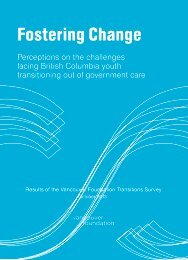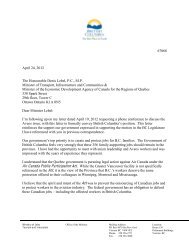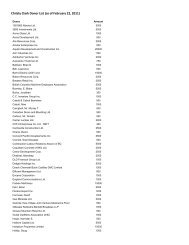from the ground up - The Tyee
from the ground up - The Tyee
from the ground up - The Tyee
You also want an ePaper? Increase the reach of your titles
YUMPU automatically turns print PDFs into web optimized ePapers that Google loves.
Airtight buildings can also create mold, where moistureproduced by students has nowhere to escape andinstead collects on, and sometimes in, <strong>the</strong> cold pointsof walls.“If it’s really cold outdoors, you could have a coldpoint on <strong>the</strong> inside, or in <strong>the</strong> middle of a wall, and youcould easily take room moisture and it finds its dewpoint and condenses and those surfaces,” says VivianLoftness, a professor of architecture at Carnegie MellonUniversity.“And <strong>the</strong> same is true in your hot, humid climates<strong>from</strong> <strong>the</strong> outside: you air condition <strong>the</strong> building, ifyou don’t manage <strong>the</strong> <strong>the</strong>rmal bridges, you could have<strong>the</strong> moisture outside <strong>the</strong> building actually condensingin <strong>the</strong> walls, which <strong>the</strong>n will breed mold and createlong term issues.”Dickens is not airtight: each classroom has windowsthat open, and <strong>the</strong> cafeteria features garage doors thatroll <strong>up</strong> in order to incorporate more light and air into<strong>the</strong> space during <strong>the</strong> warmer months.“Access to outside air is ano<strong>the</strong>r feature that we rewardthrough LEED. It also allows your occ<strong>up</strong>ants tocontrol <strong>the</strong> environment, so if I feel stuffy I can justopen a window,” says Holt.Keep it quietOne of <strong>the</strong> issues with open-concept spaces such as<strong>the</strong> Dickens cafeteria, where natural airflow replaces<strong>the</strong> need for mechanical systems, is acoustics. Whilecafeterias are not necessarily quiet places, o<strong>the</strong>r greenbuildings have found <strong>the</strong>ir open spaces are an acousticalnightmare for teachers and students.“Because <strong>the</strong>y have open airways in order to allownatural ventilation, as well as concrete floors, a lot ofgreen buildings, if you combine those with lea<strong>the</strong>rshoes, you get a real acoustic problem,” Robinsontold <strong>The</strong> <strong>Tyee</strong>.“And so in general green buildings have been designedin ways to maximize environmental benefitsand not enough attention, I believe, has been spent on<strong>the</strong> human dimension.”Not only are noisy classrooms disr<strong>up</strong>tive for learning,but also <strong>the</strong>y can create health problems for studentsand teachers who have to strain <strong>the</strong>ir voices to beheard.“Teachers trying to overcome outdoor noise willproject <strong>the</strong>ir voice at a higher level, and teacher healthwas being compromised -- <strong>the</strong>y were getting hoarse,”says Loftness.“And as soon as you provide better acoustic environmentsteachers don’t have to project <strong>the</strong>ir voices ashard and those health problems are greatly reduced.”Loftness suggests sustainable building designers gobeyond standard LEED by combining <strong>the</strong> measurementwith o<strong>the</strong>r green building standards, such asASHRAE or CHPS, in order to maximize acoustics,energy savings and <strong>the</strong> use of natural light.“Even though <strong>the</strong> standard gives you <strong>the</strong> singlecheckbox for daylight, and one checkbox for naturalventilation, I think we have to actually take a far moredramatic and concerted effort to increase <strong>the</strong> numberof checkboxes, whe<strong>the</strong>r through regional credits orthrough just a local commitment,” she says.‘Buildings should make people’s quality of life better’Much of <strong>the</strong> research on <strong>the</strong> benefits of green schoolsis still in its infancy, less than 10 years old, but Robinsonhopes to fur<strong>the</strong>r <strong>the</strong> field with <strong>the</strong> completion of<strong>the</strong> Centre for Interactive Research on Sustainability(CIRS) building on <strong>the</strong> UBC Vancouver campus laterthis year. Billed as <strong>the</strong> greenest building in NorthAmerica, with its own waste treatment system onsite,a combination of solar and geo<strong>the</strong>rmal heat, and awater system based on rainfall collection, it will alsoserve as a living laboratory, where inhabitants aremonitored for <strong>the</strong>ir happiness, health and productivity.“We think <strong>the</strong> old sustainability agenda was being lessbad, just reducing damage. <strong>The</strong> new sustainabilityagenda is being net positive, both environmentallyand in terms of human quality of life,” says Robinson.“So <strong>the</strong> buildings should make <strong>the</strong> environment better,and <strong>the</strong> buildings should make people’s quality of lifebetter.”57








